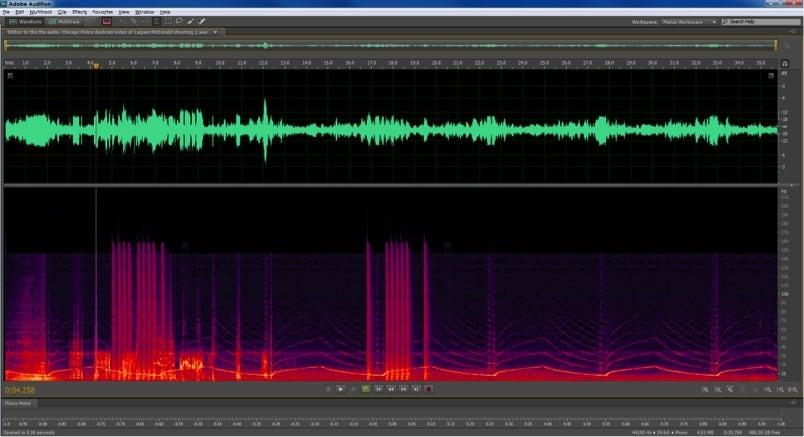The Chicago Police Department released dash cam video of the Laquan McDonald shooting. Although most dash camera video recordings include an audio track, this did not. Concerned citizens believed that the audio portion of the video recording was intentionally deleted or altered. We previously explored why there could be an absence of audio during these videos on the blog.
In the meantime, a video of the same incident, allegedly with audio, posted on YouTube. Concerned citizens believed this genuine video included the missing audio. Primeau Forensics investigated the YouTube video and here we offer an opinion as to the authenticity of this second version of the dash cam video that included audio.
During our investigation of the YouTube video titled ‘Is this the audio Chicago Police dash cam video of Laquan McDonald shooting?’, we discovered several inconsistencies that scientifically revealed the second YouTube video is a fake. Using time domain analysis, frequency domain analysis, and critical listening skills, we have outlined these anomalies and inconsistencies below.
FREQUENCY ANALYSIS

In the image above, the spectrogram reading shows the cutoff frequency of the gunshots well above the cutoff frequency of the noise floor (background noise, radio chatter & siren). Shown below, a display of the difference in frequency content between the gunshots and background noise. Red vertical sections represent gunshots.

The audio’s cutoff frequency from the YouTube video titled ‘Is this the audio Chicago Police dash cam video of Laquan McDonald shooting?’ is roughly 16 kHz. Displayed below, the audio’s cutoff frequency from the YouTube video at 16 kHz.

Audio recorded evidence produced from law enforcement vehicles contains a cutoff frequency of 4 kHz. I examined the frequency analysis of the original video that lacks audio. The cutoff frequency analysis of the original audio portion is 4 kHz and displayed below:

Based on forensic testing and analysis, I can confidently say that an unknown party manufactured and added the audio portion in the second YouTube video after the fact.

The original video contains recorded audio content of cross-talk and engine noise (see above image). The audible noises within the original video recording have low amplitude. However, they are heard with a significant increase in volume. Because this digital recorder in the police car recorded audio track, I believe the recorder was functional. Due to the lack of officer dialogue and radio chatter, we believe the on-person lavalier microphone within the vehicle was muted, disconnected, or deactivated.
INAUTHENTIC AUDIO RESULTS
The gunshots and radio chatter heard throughout the YouTube video titled ‘Is this the audio Chicago Police dash cam video of Laquan McDonald shooting?’ are duplicated, equalized, and not authentic. I previously discussed the inconsistency between the cutoff frequency of the gunshots and the background noise. In addition, the audible fingerprint of the gunshots within the spectrogram has a distinct shape, size, and intensity that are consistent with duplication or repetition. The frequency decay of the gunshot, sound of the gunshot, as well as duration of the sound are almost identical. See image below for gunshot sounds.

The radio chatter sample at timecode 0:04.387 (MM:SS:MS) is an exact duplicate of 0:03.000 (MM:SS:MS). And so, the conversation being spoken is identical. The differnece is that the duplicate has been processed using equalization to deceive the listener into believing it is radio conversation.
The Laquan McDonald police video with audio is indeed fake.

Saved like a favorite, great site!